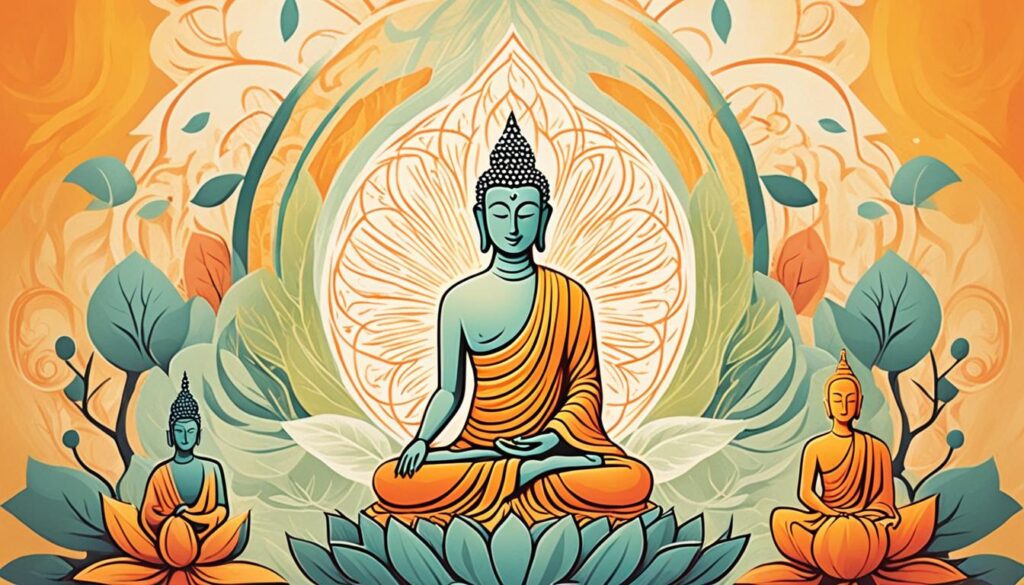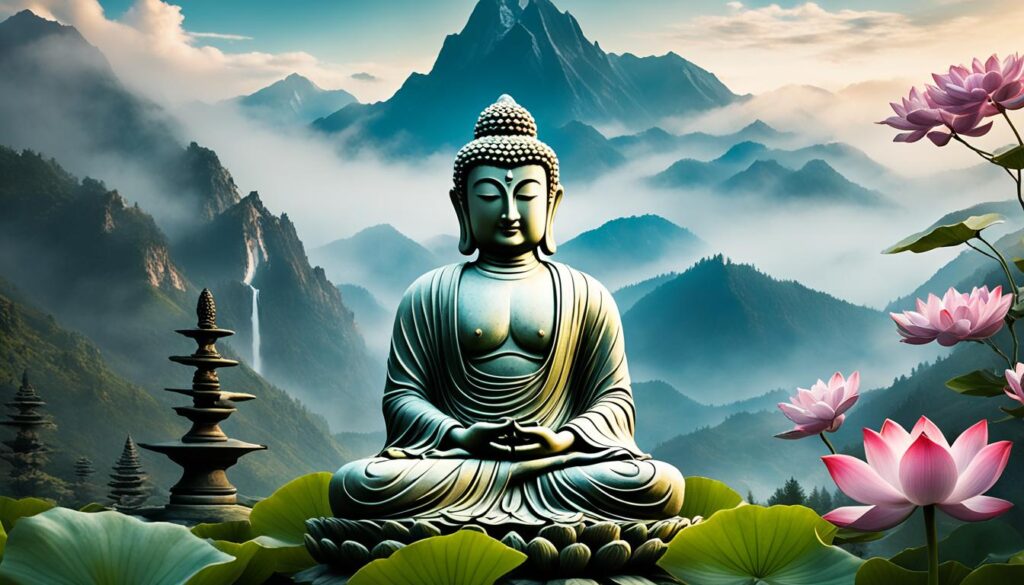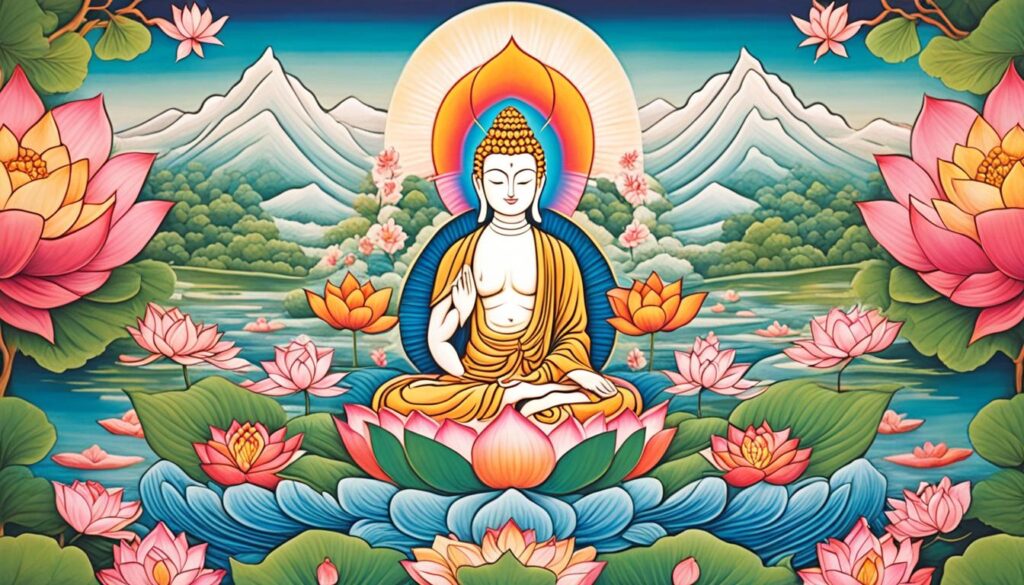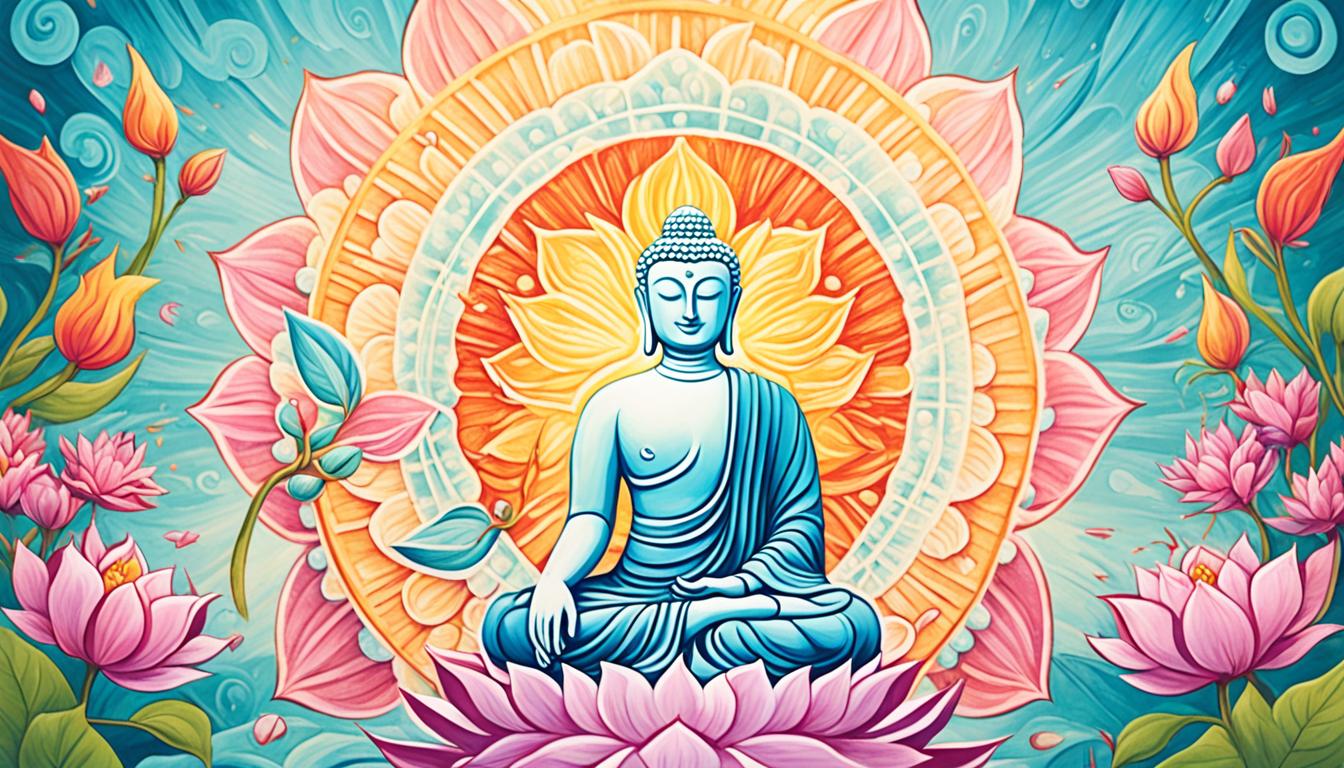Welcome to the world of Mahayana Buddhism, a path that challenges conventional beliefs and offers a greater vehicle to spiritual enlightenment. Have you ever wondered what sets Mahayana apart from other Buddhist traditions? What are its core teachings and how does it shape our understanding of reality and compassion?
In this article, we will delve into the depths of Mahayana Buddhism, exploring its origins, teachings, philosophy, devotional practices, and impact on modern society. Whether you are a curious seeker or a seasoned practitioner, join us on this journey to uncover the wisdom and transformative power of the Mahayana path.
Key Takeaways:
- Explore the origins and development of Mahayana Buddhism
- Discover the central teachings of Mahayana, including the bodhisattva path
- Understand the philosophy of emptiness and the concept of two truths
- Explore the ethical principles of compassion and the bodhisattva vow
- Learn about Mahayana devotional practices and the role of mindfulness in meditation
Origins of Mahayana Buddhism
The origins of Mahayana Buddhism are uncertain, with its development occurring gradually and in various locations. The movement’s early scriptures, known as the Mahayana sutras, were compiled roughly four centuries after the Buddha’s passing. These texts represent the innovative concepts of Mahayana Buddhism, presenting them as sermons delivered by the Buddha himself. Although Mahayana claims to be one of three vehicles, this classification fails to have any historical basis. Rather than succeeding a previous tradition, Mahayana Buddhism represents a distinctive approach to the teachings. It is worth mentioning that the term “Hinayana” is considered derogatory and does not accurately correspond to non-Mahayana Buddhism today.
Teachings of Mahayana Buddhism
The essence of Mahayana Buddhism lies in the profound teachings that guide practitioners along the bodhisattva path, a transformative journey toward enlightenment for the sake of all sentient beings. In Mahayana, the aspiration to awaken is not limited to a select few; rather, it is open to anyone who seeks to cultivate wisdom and compassion.
Mahayana philosophy builds upon the foundational Buddhist principle of “dependent origination” and expands it to encompass the concept of emptiness. Emptiness suggests that nothing possesses inherent existence and that all phenomena are interdependent. It encourages practitioners to discern the true nature of reality by developing wisdom.
Through the lens of wisdom, bodhisattvas, the compassionate heroes of Mahayana, recognize the interconnectedness of all beings. They embrace the responsibility to alleviate suffering, both in themselves and others, by embodying compassionate action. For bodhisattvas, enlightenment is not an isolated pursuit; it is intertwined with the liberation of all beings.
To attain enlightenment, Mahayana practitioners strive to cultivate both wisdom and compassion. These two qualities serve as guiding principles on the bodhisattva path, offering transformative insights and providing a roadmap for personal growth and spiritual development.
Wisdom enables practitioners to penetrate the illusion of inherent existence, to see beyond the superficial and recognize the interconnectedness of all phenomena. Through deep contemplation and insight, they come to understand the emptiness of self and other, transcending the limitations of duality and embracing the interdependence of all things.
In addition to wisdom, compassion is the heart of Mahayana teachings. It is the driving force behind the bodhisattva’s commitment to relieving suffering and promoting the well-being of all beings. With an open heart, bodhisattvas embody loving-kindness, empathy, and altruism, and strive to alleviate the physical, mental, and emotional pains of sentient beings.
Just as a table cannot stand on three legs, the bodhisattva path requires the harmonious integration of wisdom, compassion, and skillful means. Skillful means refer to the creative and adaptive methods employed by bodhisattvas to alleviate suffering according to the needs of different beings and circumstances.
The Six Perfections
The teachings of Mahayana Buddhism further elucidate the bodhisattva path through the practice of the Six Perfections (Paramitas). These six qualities represent the means by which bodhisattvas cultivate virtues and refine their practice:
- Generosity: Bodhisattvas cultivate a spirit of selfless giving, offering their time, resources, and wisdom to benefit others.
- Ethical Conduct: Bodhisattvas strive to live according to ethical principles, upholding integrity, honesty, and compassion in all their actions.
- Patience: Bodhisattvas cultivate patience in the face of challenges, embracing difficulties as opportunities for growth and transformation.
- Diligence: Bodhisattvas are dedicated and diligent in their practice, making continuous effort to develop positive qualities and overcome hindrances.
- Concentration: Bodhisattvas cultivate focused attention and deep concentration through meditation, developing clarity and insight.
- Wisdom: Bodhisattvas develop wisdom through the direct realization of emptiness, understanding the interdependent nature of all phenomena.
These Six Perfections serve as guidelines for practitioners on the bodhisattva path, providing a framework for ethical conduct, meditation, and the cultivation of wisdom and compassion.
In the next section, we will explore the grandeur of Mahayana cosmology, delving into its intricate worldview that encompasses infinite beings and worlds.
Mahayana Cosmology
Mahayana Buddhism presents a vast and fascinating cosmology that expands our understanding of the universe. According to Mahayana philosophy, the cosmos is filled with an infinite number of beings and worlds, creating a rich tapestry of existence.
In this grand vision, not only are there infinite numbers of buddhas and bodhisattvas, but there are also infinite numbers of worlds. This expansive worldview erases the boundaries between samsara, the cycle of birth and death, and nirvana, the state of enlightenment. In Mahayana, buddhas continue to exist even after they attain nirvana, emphasizing the idea that enlightenment is accessible to all beings.
This cosmology is vividly depicted in many Mahayana sutras, sacred texts that illuminate the teachings of the tradition. These sutras play a significant role in later Tantric traditions, where they serve as a source of inspiration and guidance for practitioners.
The Mahayana cosmology reminds us of the interconnectedness of all things and the boundless potential for awakening. It inspires us to explore the infinite possibilities of our own existence and embrace the vastness of the universe.

The Infinite Universe of Mahayana
Let’s take a closer look at the infinite universe of Mahayana Buddhism. The table below provides a glimpse into the grand cosmology of the tradition, where countless buddhas and bodhisattvas reside in infinite worlds.
| Buddhas | Bodhisattvas | Worlds |
|---|---|---|
| Infinite | Infinite | Infinite |
Mahayana Scriptures and Schools
The Mahayana tradition encompasses a rich collection of scriptures known as the Mahayana sutras. These ancient texts, compiled centuries after the passing of the Buddha, are repositories of the innovative ideas and profound teachings that define Mahayana Buddhism. Among the most well-known Mahayana sutras are the Lotus Sutra, the Diamond Sutra, and the Heart Sutra, each offering unique wisdom and guidance for spiritual seekers.
The development of Mahayana Buddhism has also given rise to various schools or sub-traditions, each characterized by its distinct interpretations and practices. These schools have contributed to the rich tapestry of Mahayana teachings, offering practitioners different approaches to enlightenment and personal transformation.
Here are some of the major Mahayana schools:
| School | Main Teachings and Practices |
|---|---|
| Pure Land Buddhism | Devotion to Amida Buddha, aspiring rebirth in the Pure Land |
| Zen Buddhism | Direct experiential understanding, meditation, and mindfulness |
| Tibetan Buddhism | Integration of Mahayana teachings and Vajrayana (Tantric) practices |
These schools, while distinct, share the common thread of Mahayana philosophy and offer transformative paths for spiritual growth and liberation.

Gallery of Mahayana Sutras
- Lotus Sutra
- Diamond Sutra
- Heart Sutra
- Amitabha Sutra
- Flower Ornament Sutra
- Vimalakirti Sutra
Mahayana Philosophy: Emptiness and Two Truths
Mahayana philosophy encompasses profound concepts that delve into the nature of reality and the ultimate truth. Central to Mahayana Buddhism are the teachings of emptiness (shunyata) and the concept of two truths.
Emptiness, or shunyata, is a fundamental principle in Mahayana philosophy. It refers to the inherent nature of reality, where nothing possesses independent, inherent existence. Instead, all phenomena are dependent on other factors and are interrelated. Emptiness challenges the conventional perception of solid entities and intrinsic self-nature. It invites practitioners to explore the interconnectedness and interdependence of all things.
The understanding of emptiness is crucial in Mahayana Buddhism as it goes beyond the surface level of appearances and invites deeper contemplation of the true nature of existence. By realizing emptiness, one can transcend the illusory nature of conventional reality and gain insight into the ultimate truth.
The concept of two truths further expands on the nature of reality. It distinguishes between conventional truth (samvritisatya) and absolute truth (paramarthasatya). The conventional truth represents the everyday reality we perceive through our senses and conventional thinking. It includes the subject-object dualism and the ordinary world of appearances.
On the other hand, the absolute truth reveals the ultimate nature of reality. It encompasses the understanding of emptiness and the interdependent nature of all phenomena. Absolute truth transcends the limitations of conceptual understanding and offers a profound insight into the nature of existence. It is the ultimate reality, free from illusions and delusions.
The two truths concept acknowledges the coexistence and interplay between conventional truth and absolute truth. While conventional truth is valid within the relative framework of conventional reality, absolute truth provides a deeper understanding and insight into the ultimate nature of existence.
In Mahayana Buddhism, the contemplation of emptiness and the understanding of the two truths are essential for the path to enlightenment. These philosophical concepts challenge our ordinary perception of reality, inviting us to question deeply and cultivate wisdom. By embracing emptiness and exploring the two truths, practitioners can develop a profound understanding of the interconnectedness of all things and embark on the transformative journey of liberation and awakening.

Key Points:
- Mahayana philosophy emphasizes the concept of emptiness (shunyata).
- Emptiness challenges the notion of inherent existence and the existence of solid entities.
- The concept of two truths distinguishes between conventional truth and absolute truth.
- Conventional truth pertains to everyday reality, while absolute truth reveals the ultimate nature of reality.
- The contemplation of emptiness and the understanding of the two truths are central to the path of enlightenment.
Mahayana Ethics: Compassion and Bodhisattva Vow
Compassion lies at the heart of Mahayana Buddhism, shaping its ethical principles and guiding practitioners on the path to enlightenment. In the Mahayana tradition, the bodhisattva vow is central to the ethical teachings and practices.
A bodhisattva is someone who aspires to attain enlightenment for the benefit of all sentient beings. Inspired by compassion, bodhisattvas dedicate themselves to alleviating suffering and promoting the well-being of all beings. They embody selflessness and strive to cultivate qualities such as kindness, empathy, and loving-kindness.
Taking the bodhisattva vow expresses the deep commitment to work tirelessly for the welfare and liberation of all sentient beings. It is a pledge to put the well-being of others before personal liberation. Bodhisattvas willingly delay their own enlightenment until all beings have attained awakening.
The bodhisattva vow is rooted in the understanding that all beings are interconnected and interdependent. It recognizes that one’s own liberation is inseparable from the liberation of others. By embracing this vow, practitioners commit to the cultivation of compassion, wisdom, and ethical conduct.
The bodhisattva path is not only about personal spiritual growth but also about actively engaging in compassionate action to benefit others. Bodhisattvas work to alleviate suffering, promote justice and equality, and contribute to the overall well-being of individuals and society as a whole.
Through their compassionate efforts, bodhisattvas inspire and empower others on their own spiritual journeys. They become beacons of light, shining with compassion, wisdom, and selflessness, illuminating the path to liberation and awakening.
Embracing the bodhisattva vow and cultivating compassion are not just spiritual practices, but fundamental ways of living. They inspire ethical behavior, harmonious relationships, and a deep sense of interconnectedness with all beings.
Mahayana Ethics: A Commitment to Compassion and Altruism
Practicing Mahayana ethics involves engaging in acts of kindness, generosity, and ethical conduct. The cultivation of compassion and the commitment to the bodhisattva vow serve as guiding principles for making ethical choices and living a life of virtue.
Mahayana ethics emphasizes the importance of moral conduct, encouraging practitioners to adhere to the principles of non-harm, non-violence, and respect for all beings. Bodhisattvas strive to embody the highest ethical standards, leading by example in their interactions with others.
The table below highlights some key aspects of Mahayana ethics:
| Aspect | Description |
|---|---|
| Compassionate Action | Performing acts of kindness, generosity, and selflessness to alleviate suffering and promote well-being. |
| Non-Harm | Avoiding actions that cause harm to oneself and others, practicing non-violence and non-exploitation. |
| Respect for Life | Valuing and respecting the inherent worth and dignity of all sentient beings. |
| Moral Conduct | Adhering to ethical principles and virtuous behavior, cultivating honesty, integrity, and fairness. |
| Wisdom | Developing discernment and insight to make skillful choices and act in accordance with the highest ethical values. |
Mahayana ethics encompasses the broader perspective of interconnectedness and the responsibility to work for the benefit of all beings. It inspires individuals to embrace a more compassionate and altruistic way of life, fostering a more harmonious and compassionate society.

Mahayana Devotional Practices
Mahayana Buddhism embraces various devotional practices to deepen the connection with enlightened beings. Through acts of devotion, such as veneration of buddhas, bodhisattvas, and symbolic representations like scrolls or statues, practitioners express gratitude, seek guidance, and establish a spiritual connection. Devotional practices often involve chanting mantras, offering prayers, and engaging in rituals. In Mahayana, devotion is characterized by reverence, sincerity, and a profound appreciation for the qualities and virtues of bodhisattvas and buddhas.

These devotional practices provide a means to connect with the enlightened beings and cultivate a sense of awe and inspiration. By expressing devotion, practitioners recognize and honor the wisdom, compassion, and enlightened qualities of the bodhisattvas and buddhas. Through devotion, individuals can deepen their spiritual understanding, seek guidance in their own practice, and draw inspiration from the enlightened beings who serve as role models on the path to enlightenment.
Mahayana Meditation and Mindfulness
Mahayana Buddhism emphasizes the profound significance of meditation and mindfulness in cultivating wisdom and insight on the path to liberation and enlightenment. Through various meditation techniques, such as concentration meditation (samatha) and insight meditation (vipassana), practitioners develop heightened awareness and focused attention. These practices facilitate a deep understanding of the nature of the mind and reality itself, unraveling the profound truths that lie beyond ordinary perception.
At the heart of Mahayana meditation lies the practice of mindfulness. Mindfulness entails being fully present in the current moment and cultivating non-judgmental awareness of one’s thoughts, feelings, and bodily sensations. By embracing the present moment with clarity and acceptance, practitioners foster a profound connection with their own inner experience and the world around them.
Through meditation and mindfulness, individuals can expand their consciousness, deepen their understanding of the interconnectedness of all phenomena, and cultivate a transformative wisdom that guides their actions and perspectives. With regular practice, the clarity and serenity cultivated through meditation permeate every aspect of one’s life, empowering practitioners to face life’s challenges with resilience and compassion.
The Benefits of Mahayana Meditation and Mindfulness
The practice of meditation and mindfulness in Mahayana Buddhism offers a multitude of benefits that extend beyond the individual practitioner. By developing a deep sense of presence and non-reactivity, individuals become more attuned to their own experiences and emotions, fostering emotional intelligence and self-awareness. This heightened awareness allows practitioners to navigate life’s ups and downs with greater equanimity and tranquility.
Mahayana meditation and mindfulness also cultivate compassion, one of the fundamental principles of Mahayana Buddhism. As practitioners deepen their understanding of the interconnectedness of all beings, they develop empathy and genuine concern for the well-being of others. This compassion extends not only to loved ones but also to strangers and even those perceived as adversaries, fostering a spirit of inclusiveness and unity.
Moreover, the cultivation of wisdom through meditation and mindfulness empowers individuals to perceive the world with clarity and discernment. By transcending the veils of delusion and misconception, practitioners gain insight into the true nature of reality. This profound understanding enables them to make wiser choices and live with integrity, aligning their actions with their deepest values.
Practicing Mahayana Meditation and Mindfulness
Mahayana meditation and mindfulness are accessible to practitioners of all backgrounds and levels of experience. The key is to establish a consistent practice that suits one’s individual inclinations and needs. Whether it is sitting in silence, focusing on the breath, or observing the mind’s movements, the essence lies in wholehearted presence and non-judgmental awareness.
It is helpful to incorporate meditation into a daily routine, dedicating a specific time and space for practice. By doing so, practitioners create a sacred space that supports their journey inward. Additionally, participating in meditation groups or retreats can provide a supportive community and guidance from experienced practitioners.
By engaging in regular Mahayana meditation and mindfulness practice, individuals can cultivate a transformation of consciousness, deepening their understanding of themselves and the world. This journey ultimately leads to greater wisdom, compassion, and the realization of their innate potential for awakening.

Mahayana Impact: Mindfulness and Compassion in Modern Society
The teachings of Mahayana Buddhism have had a profound impact on modern society, shaping the way we approach mindfulness and compassion. Mindfulness, rooted in Mahayana meditation practices, has become increasingly popular as a means of reducing stress, increasing self-awareness, and improving overall well-being. Many mindfulness-based programs and therapies have been developed and implemented in various areas, such as healthcare, education, and the workplace.
By cultivating mindfulness, individuals are able to develop a deeper connection with themselves and the present moment. This heightened awareness allows for greater clarity and insight, enabling individuals to navigate the complexities of modern life with more ease and resilience.
Compassion, another core principle of Mahayana Buddhism, has also had a significant impact on modern society. Mahayana’s emphasis on compassion and the bodhisattva ideal has influenced concepts like social justice, interfaith dialogue, and ethical decision-making. Compassionate actions and attitudes foster a sense of empathy, understanding, and unity, leading to more harmonious interactions and relationships.
The teachings of Mahayana Buddhism provide valuable insights and practical tools for addressing the challenges of modern life. By integrating mindfulness and compassion into our daily lives, we can cultivate a greater sense of well-being, foster healthier relationships, and contribute to the creation of a more compassionate and understanding world.
| Mahayana Impact: Mindfulness and Compassion in Modern Society |
|---|
| Mindfulness-based programs and therapies are implemented in various areas, such as healthcare, education, and the workplace |
| Mindfulness cultivates self-awareness, reduces stress, and improves overall well-being |
| Compassion influences social justice, interfaith dialogue, and ethical decision-making |
| Mahayana Buddhism offers valuable insights and practical tools for addressing the challenges of modern life |

Mahayana Buddhism in East Asia
Mahayana Buddhism has had a significant presence in East Asia, particularly in countries like China, Japan, and Korea. Various Mahayana schools, such as Pure Land Buddhism, Zen Buddhism, and Tiantai/Tendai Buddhism, have flourished in these regions.
Pure Land Buddhism
Pure Land Buddhism emphasizes devotion to Amida Buddha and the aspiration to be reborn in the Pure Land, a realm of enlightenment. Followers of Pure Land Buddhism believe in the power of Amida’s vows and his compassionate action to help sentient beings attain rebirth in his Pure Land.
Zen Buddhism
Zen Buddhism emphasizes direct experiential understanding and the practice of meditation as means to enlightenment. Zen practitioners aim to develop mindfulness, concentration, and insight through rigorous meditation and mindfulness practices. Zen Buddhism has had a profound influence on Japanese culture, art, and the mindfulness movement in the West.
Tiantai/Tendai Buddhism
Tiantai/Tendai Buddhism integrates various Mahayana teachings and practices, emphasizing the interdependence of all phenomena. It stresses the concept of the “Middle Way,” which recognizes the simultaneous validity of different Buddhist teachings and practices. Tiantai/Tendai Buddhism has contributed to the development of Buddhist philosophy, art, and rituals in East Asia.
| Mahayana Schools | Main Features |
|---|---|
| Pure Land Buddhism | Devotion to Amida Buddha Aspiration to be reborn in the Pure Land |
| Zen Buddhism | Emphasis on direct experiential understanding Practice of meditation |
| Tiantai/Tendai Buddhism | Integration of various Mahayana teachings Emphasis on interdependence of all phenomena |
The influence of Mahayana Buddhism in East Asia can be seen in various aspects of culture, art, and religious practices. The rich diversity of Mahayana schools in the region has provided practitioners with different paths and approaches to spiritual enlightenment.
Mahayana Buddhism in Tibetan Buddhism
Mahayana Buddhism has had a profound impact on Tibetan Buddhism, where it coexists with Vajrayana (Tantric) teachings. Within Tibetan Buddhism, the Gelug school, associated with the Dalai Lama, follows the Mahayana tradition. Tibetan Buddhism comprises various Mahayana schools, including Kagyu, Nyingma, Sakya, and Gelug. These schools emphasize meditation, compassionate action, and the bodhisattva path.
Combining the essence of Mahayana teachings with Vajrayana methods has given rise to the distinct philosophy and rituals found in Tibetan Buddhism. It is through the synthesis of these two traditions that Tibetan Buddhism offers a comprehensive approach to spiritual practice and enlightenment.
Mahayana Schools in Tibetan Buddhism
Let’s take a closer look at the major Mahayana schools within Tibetan Buddhism:
- Kagyu: Known for its emphasis on meditation and direct realization, the Kagyu school places great importance on the transmission of enlightened experience from teacher to student.
- Nyingma: The oldest school of Tibetan Buddhism, the Nyingma tradition emphasizes meditation and the direct awareness of the true nature of the mind.
- Sakya: With a focus on both study and meditation, the Sakya school combines the essence of Mahayana and Vajrayana teachings.
- Gelug: The Gelug school, also known as the “Virtuous Tradition,” places a strong emphasis on study, ethics, and philosophical understanding. It follows the Mahayana tradition under the leadership of the Dalai Lama.
The combination of Mahayana teachings, Vajrayana practices, and the rich cultural heritage of Tibet has shaped Tibetan Buddhism into a unique and deeply spiritual tradition. It is a path that embraces compassion, wisdom, and the aspiration to attain enlightenment for the benefit of all sentient beings.
| Table: Mahayana Schools in Tibetan Buddhism | |
|---|---|
| Kagyu | Emphasizes meditation and direct realization |
| Nyingma | Centers on the direct awareness of the true nature of the mind |
| Sakya | Combines Mahayana and Vajrayana teachings |
| Gelug | Places a strong emphasis on study, ethics, and philosophy |

Mahayana Buddhism and Pure Land Traditions
Pure Land Buddhism is a significant tradition within Mahayana Buddhism that revolves around devotion to Amitabha Buddha and the aspiration to be reborn in the Pure Land, a realm of enlightenment. Followers of Pure Land Buddhism firmly believe in the power of Amitabha’s vows and his compassionate actions to assist sentient beings in attaining rebirth in his Pure Land.
The practice of Pure Land Buddhism often involves chanting the name of Amitabha, known as the Nembutsu, and reciting sutras. This devotional approach provides solace, assurance, and a profound sense of connection to Amitabha’s compassion and wisdom. Pure Land practices are particularly popular in East Asian countries like China and Japan.

| Mahayana Buddhism | Pure Land Buddhism |
|---|---|
| Emphasizes compassion, wisdom, and the bodhisattva path | Centers around devotion to Amitabha Buddha and the aspiration to be reborn in the Pure Land |
| Believes in the liberation of all sentient beings | Believes in the power of Amitabha’s compassion and vows to assist sentient beings |
| Encourages meditation, mindfulness, and ethical conduct | Involves the recitation of the Nembutsu and the chanting of sutras |
| Comprises various schools and traditions such as Zen Buddhism and Tibetan Buddhism | Has unique practices and rituals centered around Amitabha Buddha |
Mahayana Buddhism and Zen Tradition
Zen Buddhism, a Mahayana tradition, offers a transformative path to enlightenment through direct experiential understanding and dedicated meditation practice. Zen practitioners, inspired by the teachings of ancient Zen masters, embark on a journey of self-discovery, aiming to cultivate mindfulness, concentration, and deep insight.
A central practice in Zen Buddhism is zazen, or seated meditation. During zazen, practitioners maintain a stable and upright posture while focusing their attention on the breath or a specific object. This practice helps to quiet the mind, cultivate presence, and develop a serene inner awareness.
Zen teachings often employ paradoxical questions known as koans or present unanswerable statements called hua-tou. By engaging with these enigmatic aspects of Zen practice, practitioners are encouraged to break through fixed patterns of thinking and awaken to the boundless possibilities of their own minds.
Mindfulness and Meditation in Zen Buddhism
Zen Buddhism places great emphasis on the practice of mindfulness and meditation as vehicles for self-discovery and spiritual transformation. Through rigorous meditation and the cultivation of mindfulness, Zen practitioners develop a deep awareness of the present moment, free from judgment and attachment.
The practice of mindfulness in Zen involves being fully present in each moment, attentively observing one’s thoughts, emotions, and sensations without getting caught up in them. By cultivating this non-judgmental awareness, practitioners gain insight into the impermanent nature of existence and develop a greater sense of inner peace and equanimity.
“Meditation is not a means to an end; it is both the means and the end.” – Jiddu Krishnamurti
The Influence of Zen Buddhism
The profound teachings of Zen Buddhism have had a significant impact on Japanese culture, art, and the mindfulness movement in the West. Zen monasteries, known as zenshūdōjō, have been centers of spiritual practice and enlightenment, attracting students and practitioners from all walks of life.
| Zen Buddhism | Influence |
|---|---|
| Japanese Culture | Zen aesthetics have influenced Japanese art, architecture, tea ceremonies, flower arranging, and martial arts. |
| Mindfulness Movement | Zen’s emphasis on mindfulness and present-moment awareness has played a significant role in the global mindfulness movement. |
| Western Philosophy | Zen philosophy has resonated with Western philosophers, inspiring thinkers such as Martin Heidegger and Alan Watts. |
The integration of Zen practices into daily life has allowed people around the world to connect with their inner selves, gain clarity, and find peace amidst the challenges of modern society. Zen Buddhism continues to inspire and guide individuals on the path to self-discovery and enlightenment.
Mahayana Buddhism and Tibetan Vajrayana Tradition
Tibetan Buddhism is a profound and unique tradition that integrates teachings from Mahayana Buddhism and Vajrayana (Tantric) methods. This synthesis creates a rich and multifaceted spiritual path that offers practitioners powerful tools for realization and transformation.
In Tibetan Buddhism, Vajrayana practices such as deity yoga, mantra recitation, and visualization techniques are utilized to facilitate direct realization and union with the enlightened mind. These methods, rooted in the ancient tantric tradition, allow practitioners to access the profound wisdom and compassionate qualities of awakened beings.
Mahayana teachings and practices form the foundation of Tibetan Buddhism. The bodhisattva ideal, which emphasizes the aspiration to achieve enlightenment for the benefit of all sentient beings, is central to the Mahayana tradition. Tibetan Buddhism embraces this ideal wholeheartedly, nurturing the cultivation of compassion and the altruistic intention to alleviate the suffering of all beings.
The spiritual leader of Tibetan Buddhism, the Dalai Lama, embodies the principles of wisdom and compassion that define Mahayana Buddhism. Through his teachings and actions, he inspires practitioners to cultivate the qualities of the bodhisattva on their own spiritual journeys.
Furthermore, Tibetan Buddhism’s integration of Mahayana and Vajrayana has given rise to unique rituals, art forms, and meditation practices. Elaborate mandalas, intricate thangka paintings, and resonant chants are just a few examples of the distinct expressions of devotion and spiritual exploration within Tibetan Buddhism.
The synthesis of Mahayana and Vajrayana in Tibetan Buddhism provides a comprehensive and transformative path for those seeking liberation and enlightenment. It invites practitioners to dive deep into the ocean of wisdom, compassion, and skillful means, ultimately leading to the realization of the true nature of mind and the liberation from suffering.
| Key Features of Tibetan Buddhism | Mahayana Influences | Vajrayana (Tantric) Methods |
|---|---|---|
| Emphasis on compassion and the bodhisattva ideal | √ | √ |
| View of emptiness and dependent origination | √ | √ |
| Practice of meditation and mindfulness | √ | √ |
| Utilization of ritual and symbolism | √ | √ |
| Integration of mantra recitation and visualization techniques | √ | |
| Importance of a spiritual teacher (guru) | √ |
Conclusion
Mahayana Buddhism offers invaluable teachings and practices for individuals seeking personal growth, spiritual fulfillment, and societal harmony. With its emphasis on compassion, wisdom, and the bodhisattva path, Mahayana encourages everyone to aspire to achieve enlightenment and work for the benefit of all beings.
The impact of Mahayana Buddhism extends beyond its origins and has influenced various cultures and traditions, particularly in East Asia and Tibetan Buddhism. Its teachings on mindfulness, compassion, and the cultivation of wisdom continue to resonate with people worldwide, providing guidance for navigating the challenges of modern life and finding inner peace and enlightenment.
By incorporating devotional practices, meditation techniques, and ethical principles, Mahayana Buddhism offers a comprehensive framework for personal and spiritual development. Through the bodhisattva vow, Mahayana practitioners commit themselves to the path of liberation and dedicate their lives to benefiting others, recognizing the interconnectedness of all beings.
Whether seeking solace, personal growth, or a deeper understanding of reality, Mahayana Buddhism provides the tools and teachings necessary to embark on a transformative journey. By embracing compassion, cultivating wisdom, and adopting the bodhisattva path, individuals can find fulfillment and contribute to creating a more compassionate and enlightened society.

